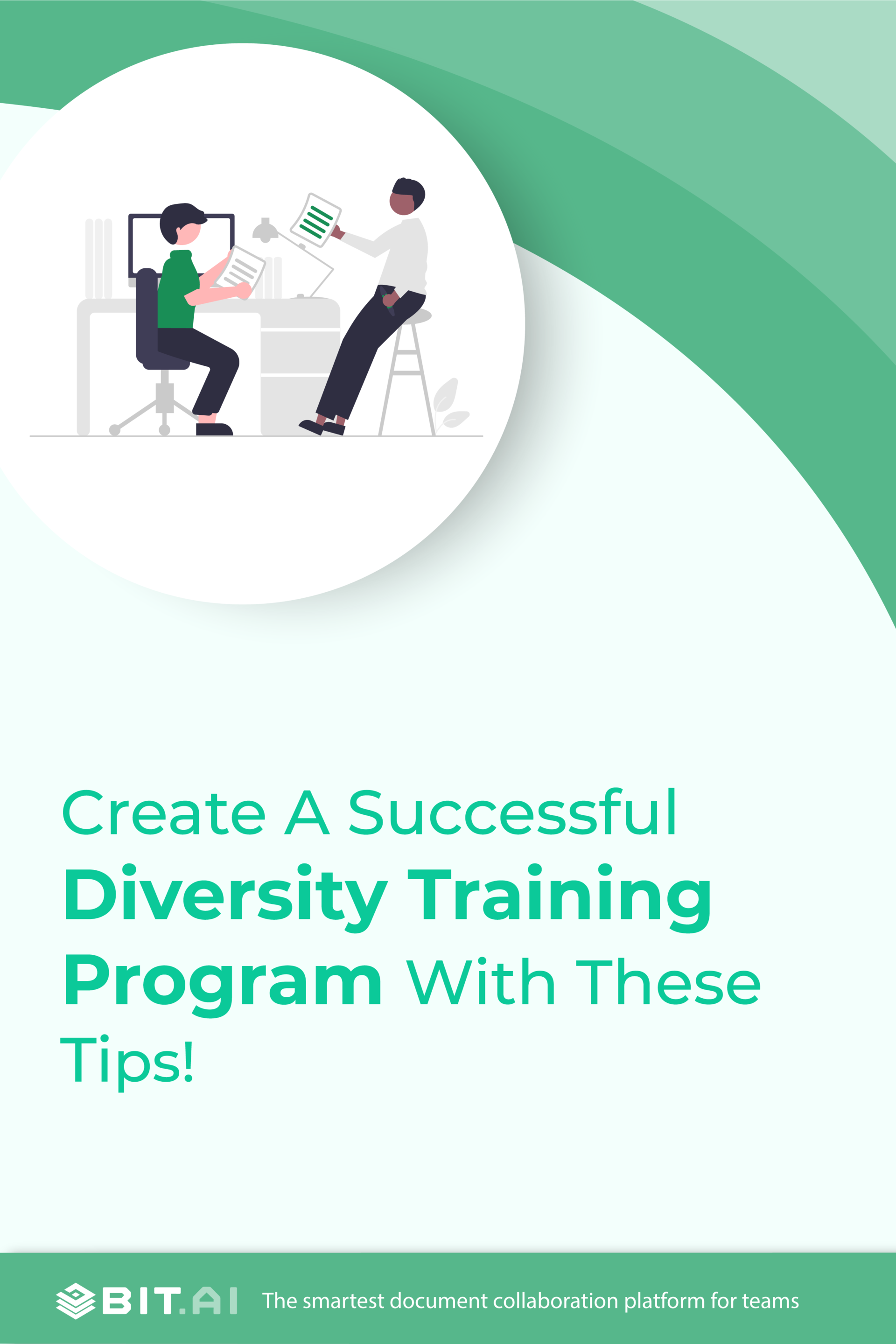In today’s rapidly changing world, companies are realizing that embracing diversity isn’t just a nice-to-have, it’s a must-have. And that’s where diversity training comes in!
Picture this: a workplace that’s a vibrant melting pot of cultures, perspectives, and experiences, where collaboration and innovation thrive. Sounds amazing, right? Well, diversity training is the key to unlocking that incredible potential.
So if you’re looking to learn a little about diversity training in the workplace, then you’re in the right spot! In this blog, we will take you on a tour of the meaning, benefits, types, and practical strategies for diversity training and its success. Let’s go!
What’s A Diversity Training Program?
A diversity training program is an educational initiative designed to promote understanding, acceptance, and inclusion of individuals from diverse backgrounds within an organization or community. It aims to enhance cultural competency, reduce biases, and foster a more inclusive and equitable environment.
These programs typically involve workshops, seminars, or interactive sessions that provide participants with knowledge about various dimensions of diversity, such as race, ethnicity, gender, sexual orientation, religion, disability, and socioeconomic status.
Diversity training programs often explore topics such as unconscious bias, privilege, stereotypes, and systemic inequalities. They encourage participants to reflect on their own biases, challenge assumptions, and develop skills to interact respectfully and effectively with people from different backgrounds.
The ultimate goal of a diversity training program is to create a more inclusive workplace or community where all individuals feel valued, respected, and able to contribute their unique perspectives and talents.
Why is Diversity Training Important?
Diversity training is important for several reasons as it helps organizations foster inclusivity and create a more harmonious and productive work environment. Here are six key points explaining the importance of diversity training:
1. Promoting Equal Opportunities
Diversity training is essential as it ensures equal opportunities for all employees, irrespective of their race, gender, ethnicity, or other protected characteristics. By eliminating bias and discrimination, it creates a level playing field where individuals can compete and progress based on their merits and abilities.
Diversity training raises awareness about unconscious biases and stereotypes, enabling employees to recognize and challenge their own preconceptions. As a result, decision-making processes become more objective, fair, and free from discriminatory practices.
2. Enhancing Cultural Competence
Imagine diversity training as a magical key that unlocks the door to understanding different cultures. It’s like getting a crash course on how to navigate the world of diversity. By arming employees with knowledge and understanding, it builds their cultural competence superpower.
This means they can communicate effectively, collaborate seamlessly, and truly appreciate diverse perspectives. It’s like creating a dream team where teamwork and innovation skyrocket because everyone brings their unique experiences to the table.
3. Mitigating Bias and Stereotypes
Sometimes we make unfair judgments without even realizing it and this often hinders fair decision-making processes. Here is where diversity training comes in and helps people become aware of and deal with their hidden biases and stereotypes. It teaches employees to recognize and question their own preconceived notions, so they can be more fair in their decision-making.
It’s all about giving everyone a fair chance. By going through this training, people learn how to be more objective and treat everyone equally. It’s like opening their eyes to biases they didn’t know they had, and that’s how we create a more inclusive and just workplace.
4. Creating Inclusive Workplaces

Diversity training plays a crucial role in promoting inclusivity by bringing attention to the unique experiences and obstacles faced by various social groups. It cultivates empathy and understanding among employees. This creates an atmosphere where everyone is acknowledged, appreciated, and embraced.
By increasing awareness about diverse perspectives, diversity training helps individuals recognize the importance of respect and value for all. It’s all about building a workplace environment where each person feels heard, valued, and included, regardless of their background.
5. Improving Customer Relations
In a diverse world, organizations that embrace diversity have an advantage in serving different types of customers. And this is where diversity training comes into play and helps employees learn how to connect with customers from various backgrounds. By understanding and respecting their needs, businesses can make customers happier and more loyal.
When employees are trained to appreciate diversity, they can provide better service that feels personal and inclusive. That’s why diversity training is important. It helps organizations succeed by valuing and understanding the diverse people they serve.
6. Enhancing Organizational Reputation
A commitment to diversity and inclusion is increasingly valued by stakeholders, including customers, investors, and potential employees. When organizations prioritize diversity training, it shows their commitment to fostering a fair and inclusive work environment. This dedication enhances their reputation and makes them more appealing as an employer.
By investing in diversity training, organizations not only do the right thing but also gain a competitive advantage by attracting stakeholders who value diversity and inclusion. Ultimately, prioritizing diversity training benefits both the organization and its stakeholders by creating a positive and inclusive workplace culture.
Now that we’ve discussed the benefits of diversity training, let’s explore some of the different types of diversity training programs that organizations can implement.
6 Types of Diversity Training
1. Awareness Training
Awareness training is a type of diversity training that focuses on raising awareness among employees about various aspects of diversity, such as race, ethnicity, gender, sexual orientation, religion, age, and abilities. The training aims to help participants recognize their own biases, challenge stereotypes, and understand the importance of creating an inclusive and respectful work environment.
2. Skill-based Diversity Training
Skill-based diversity training goes beyond awareness and provides employees with practical skills to effectively navigate diversity in the workplace. It may include workshops or activities that enhance communication, teamwork, conflict resolution, and cultural competence. The training focuses on developing specific skills that enable employees to work collaboratively and respectfully with individuals from diverse backgrounds.
3. Diversity Audits

Diversity audits involve assessing an organization’s current diversity and inclusion practices. This type of training involves conducting a comprehensive review of policies, procedures, hiring practices, promotion processes, and overall organizational culture to identify areas where diversity and inclusion can be improved. The audit findings help organizations develop targeted strategies to enhance diversity and create more inclusive practices.
4. Intermediate Diversity Training
Intermediate diversity training is designed for employees who have already received basic diversity training. It builds upon the foundational knowledge and skills acquired in the basic training and delves deeper into more complex diversity issues. This type of training may focus on topics like intersectionality, systemic bias, privilege, and allyship, providing employees with a deeper understanding of the complexities of diversity and the tools to address them effectively.
5. Basic Diversity Training
Basic diversity training serves as an introductory course for employees who may have limited exposure to diversity and inclusion concepts. It covers fundamental topics such as the importance of diversity, recognizing and valuing differences, understanding unconscious biases, and promoting inclusivity. This type of training provides a broad overview of diversity-related issues and sets the foundation for further learning and development.
6. Mobile Learning
Mobile learning refers to diversity training programs or resources that are accessible through mobile devices such as smartphones or tablets. This type of training recognizes the convenience and flexibility of mobile technology and allows employees to engage in diversity training at their own pace and convenience. Mobile learning can include interactive modules, videos, quizzes, or discussion forums that employees can access anytime and anywhere.
Now you know the different types of diversity training out there, so let’s move on to how to create a successful diversity training program!
How To Create A Succesful Diversity Training Program?
1. Be Proactive
Taking a proactive approach to diversity and inclusion means not waiting for problems or incidents to occur before addressing diversity-related issues. Instead, organizations must recognize the importance of creating a diverse and inclusive workplace from the outset.
Understand that diversity brings numerous benefits, such as increased innovation, creativity, and productivity. By being proactive, organizations can demonstrate their commitment to fostering an inclusive environment where individuals from diverse backgrounds are valued and respected. This proactive stance helps prevent issues and promotes a culture that embraces diversity as a fundamental value.
2. Develop a Safe Space
When it comes to diversity training, creating a safe and inclusive space is key. It’s all about setting some ground rules that encourage open and honest discussions in a respectful and supportive environment. These rules make sure that everyone listens actively, tries to understand each other empathetically, and appreciates all experiences and perspectives.
By establishing these guidelines, people feel more comfortable sharing their thoughts and ideas without worrying about being judged or facing any negative consequences. It creates room for authentic dialogue, helps everyone gain a deeper understanding of different viewpoints, and ensures that everyone’s voice is heard and respected.
3. Identify Areas of Concern
Conducting a comprehensive assessment within an organization is a crucial step toward fostering diversity and inclusion. It allows the organization to identify potential areas where diversity may be lacking or where biases and stereotypes may be prevalent. This assessment entails multiple approaches such as collecting feedback from employees through surveys or focus groups, reviewing existing policies and practices, and analyzing diversity-related metrics such as representation and retention rates.
By engaging employees and capturing their perspectives, the assessment process provides valuable insights into the experiences and challenges faced by diverse individuals within the organization. Reviewing policies and practices helps identify any systemic barriers or biases that may hinder inclusivity. Additionally, analyzing diversity-related metrics provides a quantitative understanding of the organization’s current state of diversity.
All of this will pinpoint specific areas that need improvement and will help develop diversity training programs that address unconscious biases, promote inclusive behaviors, and create a more welcoming and equitable work environment.
4. Create a Culture of Inclusion
Imagine being part of a company where everyone feels valued and included, regardless of their background or identity. That’s what fostering a culture of inclusion is all about.
One of the ways to achieve this is by promoting diversity in hiring practices. It’s not just about ticking boxes, but actively seeking out candidates from diverse backgrounds. Equal opportunities for career growth and development are also important. This can be achieved through mentorship programs, training initiatives, and providing the necessary support for employees to reach their full potential.
In addition, fair and unbiased treatment in all employment processes is crucial. Whether it’s promotions, pay, or assignments, everyone should be treated fairly and with respect. Transparent policies and procedures help ensure that every employee gets a fair shake. Together, these efforts can create a workplace where everyone feels valued, respected, and included.
5. Create Diverse Teams

A lot of organizations claim to teach diversity but fail to put it into practice. However, if you have diverse team members at all levels of your organization, it will help your team members see and appreciate the human qualities in people from different backgrounds. It’s not enough to just talk about diversity, you need to actively seek out qualified team members from diverse backgrounds, so they can learn to collaborate and build relationships with one another.
To promote diversity in teams, organizations can be intentional about forming groups that include individuals from various ethnicities, genders, ages, and professional backgrounds. Another way is to promote team-building exercises and collaborative projects. They provide opportunities for team members to interact, learn from one another, and appreciate the diverse contributions each person brings to the table.
6. Include Employees of All Levels
Including employees of all levels in a diversity training program is a powerful strategy that fosters inclusivity and strengthens organizational culture. Think about all the collective wisdom and perspectives a company can get by simply involving employees of all levels, from executives to entry-level staff, in the conversation and processes.
This approach not only enhances empathy and understanding but also promotes a sense of belonging and equal opportunity. Employees at all levels benefit from exposure to different viewpoints and challenges. This helps with increased collaboration, innovation, and problem-solving.
7. Set Clear Boundaries
Establishing clear boundaries is essential to create a respectful and inclusive environment. After all, clarity ensures that there isn’t any room for confusion. To achieve this, organizations must communicate and reinforce policies and procedures that directly tackle discrimination, harassment, and bias.
By clearly defining what is considered appropriate behavior and explicitly stating the consequences for violations, organizations can create a safe and inclusive space during diversity training. This approach ensures that participants fully grasp the expectations and are aware that discriminatory actions will not be tolerated under any circumstances.
8. Tailor a Program That Fits Your Company
When developing a diversity training program, it’s important to tailor it to the specific needs and goals of the organization. This customization involves taking into account the unique challenges and dynamics within the company.
To do this effectively, assess your organization’s areas of concern, identify any knowledge or skills gaps related to diversity and inclusion, and then design training modules that specifically address those issues. By tailoring the program, organizations can ensure that the training is relevant and resonates with their employees.
Engaging with external diversity and inclusion experts can be highly beneficial in this process. These experts bring valuable insights, best practices, and expertise to the table. They can help identify blind spots, offer fresh perspectives, and provide guidance on designing an effective and impactful training program.
9. Celebrate Diversity
Diversity training doesn’t have to be all serious and formal. Injecting fun and celebration into the program can make it more engaging and memorable. This can be done in various ways:
- Cultural Expos: Organize events that celebrate different cultures within the organization. This can include food tastings, music and dance performances, traditional attire showcases, and interactive displays. It’s a fantastic opportunity for employees to learn about and appreciate the richness of various cultures.
- Diversity Days: Dedicate specific days to celebrate and recognize diverse holidays and observances. Encourage employees to share their customs and traditions, organize themed activities, or invite guest speakers to educate others about different cultural practices.
- Employee Spotlights: Showcase the success stories of employees from diverse backgrounds. This can be done via videos, interviews, or written profiles that highlight their achievements and contributions.
- Interactive Workshops: Conduct interactive workshops that promote cultural awareness and understanding. These workshops can include team-building activities, role-playing exercises, or group discussions that encourage participants to share their perspectives and experiences.
- Diversity Challenges: Organize friendly competitions or challenges that encourage employees to learn more about diversity. This can include trivia quizzes, scavenger hunts, or online games that test knowledge and spark discussions on various aspects of diversity.
Remember, the key is to create an atmosphere of celebration, appreciation, and learning. By infusing fun into diversity training, organizations can foster a sense of belonging, strengthen relationships among employees, and reinforce the value and importance of inclusivity.
Wrap Up
Ultimately, diversity training paves the way for a harmonious and thriving workplace, where every individual feels valued, respected, and empowered to contribute their unique perspectives and experiences.
Whether you’re an employer searching for ways to build an inclusive culture or an employee interested in personal growth, we hope this blog has helped you become more inspired, enlightened, and empowered.
Together, let’s create workplaces that celebrate uniqueness, foster understanding, and cultivate an environment where everyone feels valued. It’s time to break down barriers and create a brighter, more diverse future!
Further Reads:
How to Build a Peer-to-Peer Recognition Program?
Farewell Messages For Co-Workers: Make The Last Goodbye Memorable!
The Benefits & Drawbacks of Working Remote (WFH)
Organizational Ethics: Definition, Importance & Examples!
Remote Work Challenges and How To Overcome Them Like a Pro?
How to Encourage Knowledge Sharing in the Workplace?
Writing Vision Statement: Definition, Examples and Best Practices!


